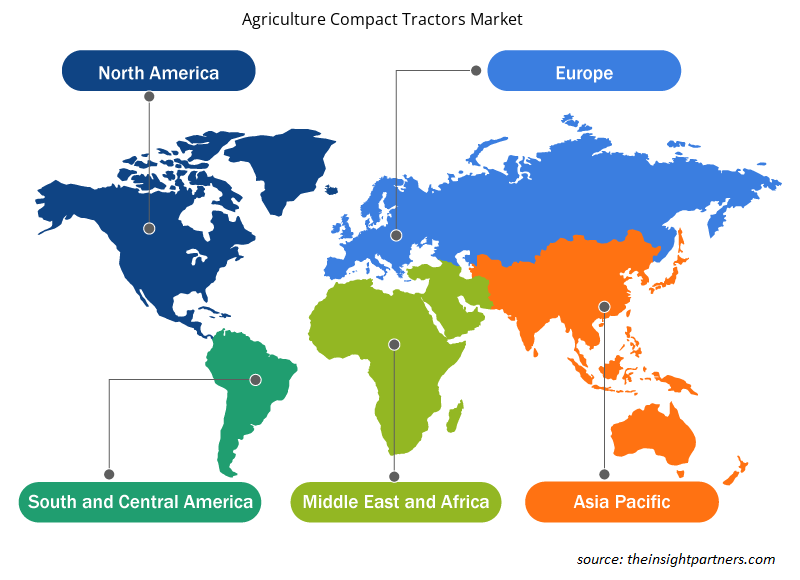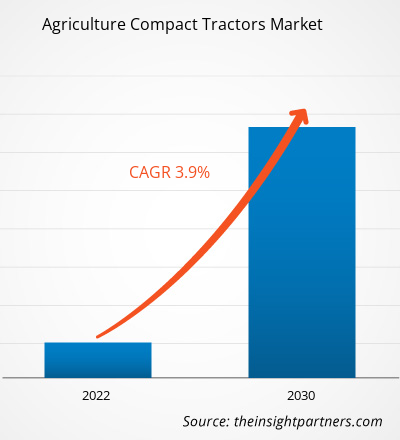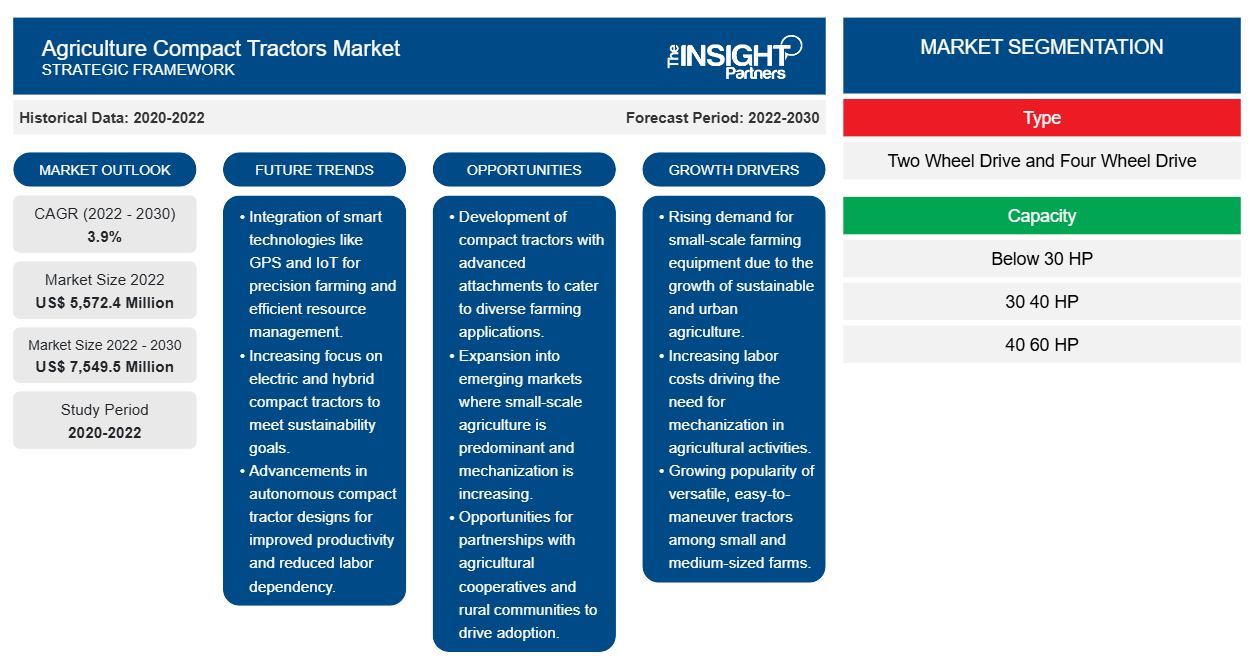[연구 보고서] 농업용 소형 트랙터 시장 규모는 2022년 5,572.4백만 달러에서 2030년 7,549.5백만 달러로 성장할 것으로 추산되며, 시장은 2022년에서 2030년까지 3.9%의 CAGR을 기록할 것으로 예상됩니다.CAGR of 3.9% from 2022 to 2030.
분석가 관점:
지속적으로 성장하는 농업 부문과 현대 장비에 대한 선호도가 증가함에 따라 글로벌 농업용 소형 트랙터 시장이 성장하고 있습니다. 인구가 지속적으로 증가함에 따라 식량 수요가 증가하고 있습니다. 유엔이 최근 발표한 예측에 따르면 세계 인구는 2030년까지 85억 명에 도달하고 2050년까지 97억 명으로 늘어날 것으로 예상됩니다. 그 결과 농산물에 대한 수요가 급격히 증가하여 농부들이 농장 수확량을 늘려야 하는 부담이 커지고 있습니다. 따라서 농업 활동 규모가 커짐에 따라 농업용 소형 트랙터에 대한 수요가 증가하고 있습니다.
2024년 1월, 한국의 중장비 및 전자부품 제조업체인 LS Mtron Co.는 북미에서 새로운 MT2·MT2E 소형 트랙터 시리즈를 출시했습니다. 이 시리즈의 두 모델(프리미엄 MT2와 저가형 MT2E)은 제한된 장소에서의 작동 편의성을 개선하도록 설계되었으며 소규모 농장에 적합합니다. 이 제품 라인업은 부드러운 전진 및 후진 작동을 위한 사용하기 쉬운 셔틀과 토양이나 자갈을 옮기는 데 적합한 듀얼 페달을 포함하여 다양한 작업을 위해 설계되었습니다. 농업용 소형 트랙터 제조업체의 이러한 제품 개발 활동은 농업용 소형 트랙터 시장 성장을 촉진합니다.
시장 개요:
일반적으로 컴팩트 유틸리티 트랙터로 알려진 컴팩트 트랙터는 주로 쟁기질, 잔디 깎기, 심기, 경운 및 운반과 같은 소규모 농장 활동에 사용됩니다. 크기와 용량이 더 작고 소규모 농장, 과일 및 견과류 농장, 포도원, 정원 및 잔디밭에 더 유익합니다. 컴팩트 트랙터는 연료 소모량이 적고 유지 관리 요구 사항이 낮아 운영 비용이 낮습니다.
아시아 태평양 지역은 중국과 인도와 같은 국가에서 대규모 농업 활동으로 인해 농업용 소형 트랙터 시장을 지배하고 있습니다. 그러나 북미와 유럽은 예측 기간 동안 강력한 CAGR 값을 기록할 것으로 예상됩니다. 미국은 견과류와 과일의 주요 생산국 중 하나입니다. 미국 농무부가 2022년에 발표한 데이터에 따르면 소규모 가족 농장이 미국 전체 농장의 88%를 차지했습니다. 따라서 미국에 소규모 농장이 많은 것은 이 나라의 농업용 소형 트랙터 시장에 도움이 되는 핵심 요소입니다.
귀하의 요구 사항에 맞게 이 보고서를 사용자 정의하세요
이 보고서의 일부 또는 국가 수준 분석, Excel 데이터 팩을 포함하여 모든 보고서에 대한 사용자 정의를 무료로 받을 수 있으며 신생 기업 및 대학을 위한 훌륭한 혜택과 할인 혜택을 이용할 수 있습니다.
-
이 보고서의 주요 시장 동향을 알아보세요.이 무료 샘플에는 시장 동향부터 추정 및 예측까지 다양한 데이터 분석이 포함됩니다.
시장 동인:
소규모 농가를 지원하기 위한 정부 이니셔티브
정부 정책과 자금 지원과 같은 지원 이니셔티브는 다양한 국가의 소규모 농장 수를 늘립니다. 예를 들어, 미국 농무부는 소규모 및 초보 농부에게 간단한 신청을 통해 최대 35,000달러의 대출을 받을 수 있는 소액 대출 프로그램을 제공합니다. 또한 2023년 가이아나 정부는 National Pathway for Food Systems 프로그램을 통해 이니셔티브를 발표했습니다. 이 프로젝트의 일환으로 농장 투입물 공급품과 일회성 현금 보조금이 전국의 소규모 농부와 지속적인 사회경제적 권한 부여 프로그램 참여자에게 제공되었습니다. 이러한 정부 이니셔티브는 소규모 농부가 소형 트랙터를 포함한 농업 장비를 채택할 수 있도록 지원하고 있습니다. 더욱이 이러한 프로그램과 이니셔티브는 개발도상국과 선진국의 소규모 농업 농장에 유리한 환경을 조성하여 궁극적으로 농업용 소형 트랙터 시장 규모가 확대되는 결과를 가져왔습니다.
세그먼트 분석:
농업용 소형 트랙터 시장 분석은 다음 세그먼트를 고려하여 수행되었습니다. 유형, 용량 및 응용 프로그램. 용량을 기준으로 시장은 30HP 미만, 30HP-40HP 및 40HP-60HP로 세분화됩니다. 40HP-60HP 및 30HP-40HP 세그먼트는 농업용 소형 트랙터 시장 점유율의 50% 이상을 차지합니다. 이 트랙터는 쟁기질, 경운, 심기 및 수확과 같은 작업을 위해 중소 규모 농장에 적합합니다. 예를 들어 Farmtrac은 2024년에 새로운 Farmtrac 60 Powermaxx 트랙터를 출시했습니다. 이 트랙터는 55 HP 엔진을 탑재하고 여러 가지 기능을 제공합니다.
지역 분석:
농업용 소형 트랙터 시장 보고서의 지리적 범위는 북미(미국, 캐나다, 멕시코), 유럽(스페인, 영국, 독일, 프랑스, 이탈리아, 유럽의 나머지 지역), 아시아 태평양(한국, 중국, 인도, 일본, 호주, 아시아 태평양의 나머지 지역), 중동 및 아프리카(남아프리카, 사우디 아라비아, UAE, 중동 및 아프리카의 나머지 지역), 남중부 아메리카(브라질, 아르헨티나, 남중부 아메리카의 나머지 지역)로 구성됩니다. 아시아 태평양 지역은 2022년에 농업용 소형 트랙터 시장 점유율이 가장 컸습니다.
북미 농업용 소형 트랙터 시장은 미국, 캐나다, 멕시코로 구분됩니다. 특히 미국, 캐나다, 멕시코와 같은 국가의 북미 농업 부문은 농업용 소형 트랙터에 대한 수요를 주로 주도합니다. 농업 부문의 확장과 지속적인 제품 개발은 앞으로도 이 지역의 시장을 계속 촉진할 것입니다. 미국 농무부가 2021년에 발표한 데이터에 따르면 농업 부문은 2021년에 미국 GDP에 약 1조 2,640억 달러를 기여했으며, 이는 국가 GDP의 5.4%를 차지합니다. 캐나다 정부가 2022년에 발표한 데이터에 따르면 농업 및 농식품 부문은 캐나다 경제에 상당한 기여를 합니다. 연간 5.6%의 비율로 성장하는 캐나다 농산물 판매는 2022년에 877억 달러에 달했습니다. 소규모 농장의 수가 증가함에 따라 소형 트랙터에 대한 수요가 증가하여 공급업체에 새로운 성장 기회를 제공합니다. 또한, 미국 내 많은 주요 기업들은 현재 완전 자동화된 소형 트랙터 개발에 주력하고 있으며, 이러한 개발은 향후 몇 년 안에 북미 지역에 새로운 농업용 소형 트랙터 시장 트렌드를 가져올 것으로 예상됩니다.
농업 소형 트랙터 시장 지역 통찰력
Insight Partners의 분석가들은 예측 기간 동안 농업용 컴팩트 트랙터 시장에 영향을 미치는 지역적 추세와 요인을 철저히 설명했습니다. 이 섹션에서는 북미, 유럽, 아시아 태평양, 중동 및 아프리카, 남미 및 중미의 농업용 컴팩트 트랙터 시장 세그먼트와 지리에 대해서도 설명합니다.

- 농업용 소형 트랙터 시장에 대한 지역별 특정 데이터 얻기
농업용 소형 트랙터 시장 보고서 범위
| 보고서 속성 | 세부 |
|---|---|
| 2022년 시장 규모 | 5,572.4백만 달러 |
| 2030년까지 시장 규모 | 7,549.5백만 달러 |
| 글로벌 CAGR (2022-2030) | 3.9% |
| 역사적 데이터 | 2020-2022 |
| 예측 기간 | 2022-2030 |
| 다루는 세그먼트 |
유형별로
|
| 포함된 지역 및 국가 |
북아메리카
|
| 시장 선도 기업 및 주요 회사 프로필 |
|
농업 소형 트랙터 시장 참여자 밀도: 비즈니스 역학에 미치는 영향 이해
농업용 소형 트랙터 시장은 소비자 선호도의 변화, 기술 발전, 제품의 이점에 대한 인식 증가와 같은 요인으로 인해 최종 사용자 수요가 증가함에 따라 빠르게 성장하고 있습니다. 수요가 증가함에 따라 기업은 제품을 확장하고, 소비자의 요구를 충족하기 위해 혁신하고, 새로운 트렌드를 활용하여 시장 성장을 더욱 촉진하고 있습니다.
시장 참여자 밀도는 특정 시장이나 산업 내에서 운영되는 회사나 기업의 분포를 말합니다. 주어진 시장 공간에 얼마나 많은 경쟁자(시장 참여자)가 존재하는지 그 규모나 전체 시장 가치에 비해 나타냅니다.
농업용 소형 트랙터 시장에서 활동하는 주요 회사는 다음과 같습니다.
- 얀마 트랙터
- 마힌드라
- TYM 주식회사
- 솔렉트랙
- 존 디어
면책 조항 : 위에 나열된 회사는 어떤 특별한 순서에 따라 순위가 매겨지지 않았습니다.

- 농업용 소형 트랙터 시장의 주요 업체 개요를 알아보세요
주요 플레이어 분석:
AGCO GmbH, Yamaha Tractors, Solis, Bobcat Company, Mahindra Tractors, Kubota, John Deere, Massey Ferguson, New Holland는 농업용 소형 트랙터 시장 보고서에 소개된 주요 기업입니다. 이러한 기업 외에도 이 연구에서는 여러 다른 중요한 기업을 연구하고 분석하여 글로벌 유틸리티 소형 트랙터 시장에 대한 전체적인 개요를 얻었습니다.
최근 개발 사항:
합병 및 인수와 같은 무기적 및 유기적 전략은 글로벌 농업용 소형 트랙터 시장에서 많은 회사에서 채택하고 있습니다. 보도 자료에 따르면, 주요 농업용 소형 트랙터 시장 참여자의 최근 개발 사항은 다음과 같습니다.
년도 |
소식 |
지역 |
|
2023년 8월 |
Case IH는 새로운 Farmall Subcompact 25SC 트랙터를 출시했습니다. 이 새로 출시된 모델은 Case IH 포트폴리오에서 가장 작은 트랙터입니다. 이 새로운 트랙터는 25마력에서 115마력까지의 엔진 범위를 가지고 있습니다. |
아시아 태평양 |
|
2023년 2월 |
Bobcat은 1000, 2000, 4000 시리즈라는 이름의 새로운 소형 트랙터 라인업을 출시했습니다. 이 시리즈에는 엔진 출력을 기준으로 차별화된 9개의 소형 트랙터 모델이 있습니다. 이 트랙터의 출력 범위는 25~85마력입니다. |
유럽 |
- 과거 분석(2년), 기준 연도, CAGR을 포함한 예측(7년)
- PEST 및 SWOT 분석
- 시장 규모 가치/거래량 - 글로벌, 지역, 국가
- 산업 및 경쟁 환경
- Excel 데이터세트
최근 보고서
사용 후기
구매 이유
- 정보에 기반한 의사 결정
- 시장 역학 이해
- 경쟁 분석
- 고객 인사이트
- 시장 예측
- 위험 완화
- 전략 기획
- 투자 타당성 분석
- 신흥 시장 파악
- 마케팅 전략 강화
- 운영 효율성 향상
- 규제 동향에 발맞춰 대응























 무료 샘플 받기 - 농업용 소형 트랙터 시장
무료 샘플 받기 - 농업용 소형 트랙터 시장